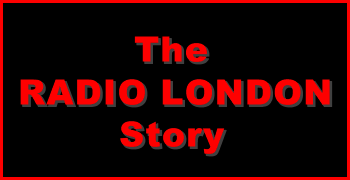Part Three: Adrift
In November 1965 Kenny Everett was fired. Despite being hugely popular, the DJ had consistently made fun of The World Tomorrow, the evangelical programme scheduled in his show. This sponsored half-hour, fronted by Garner Ted Armstrong or his father Herbert W Armstrong, brought in so much money that the Big L management could not afford to upset them. Kenny had to go. (He was allowed to return to the station
in June 1966 after promising to behave himself.)
|

|
|
Daily Mail headline, 12th January 1966. Cutting below.
|
|
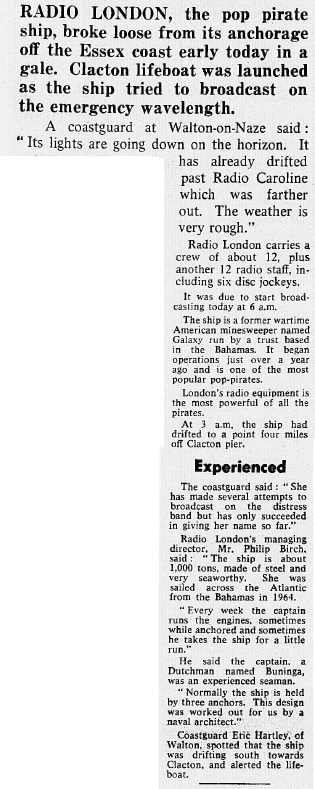
|
|
Daily Mail 12th January 1966. Click to magnify. More press cuttings about the drifting here.
|
In the early hours of 12th January 1966 Radio London's ship, the mv Galaxy, dragged her anchor in a gale. Mark Roman was on board at the time: “I was woken up and (someone)
said we are adrift. So we got up and put our life-jackets on and Dave Dennis made a cup of tea and we sat in the ward room ... (Unfortunately) when the steering gear was connected, something broke and
it didn't work, so we couldn't steer with the rudder. Normally, when a ship's got two engines, you can steer on the engines - which is fine but our engines were in different water-tight compartments because it was (previously)
a war ship. There's a watertight compartment between each engine which is a damned good idea when ... you're in a war-time situation, but difficult when you've only got one engineer on board, who can only control one engine. So the captain said ‘I'll just steer on one engine. All I've got to do is, when I'm pointing in the wrong direction, I'll go hard astern and, when I'm pointing in the right direction, I'll go hard ahead’. And that's what he did.
All night.” The Clacton lifeboat was launched but, in the event, was not needed. Radio London was off the air the next morning as the Galaxy had drifted inside territorial waters but, by lunchtime, she was back at her anchorage.
At 1pm programmes resumed. It was a nerve-wracking time for Dutch steward Thys Spyker. After the ship's drifting he transferred to Caroline South and he arrived there just in time for that ship to lose her anchor as well. And this
time the ship did not just drift; she ended up on the beach.
At the end of February the station experimented with extended broadcasting hours and in March this became permanent with the addition to the schedule of The Kaye Club, hosted by Paul Kaye between
9pm and 12, and London After Midnight rounding off the day's programmes until 2am. Ben Toney left the station around this time and Alan Keen, formerly an airtime salesman, replaced him as programme
director.
 Paul Kaye with the 8am ‘news in brief’ and Dave Cash on The Rabbit Patch Breakfast Show from 24th February 1966. This clip is taken from a recording available from
www.azanorak.com. Our thanks to Ray Robinson (duration 4 minutes 45 seconds)
Paul Kaye with the 8am ‘news in brief’ and Dave Cash on The Rabbit Patch Breakfast Show from 24th February 1966. This clip is taken from a recording available from
www.azanorak.com. Our thanks to Ray Robinson (duration 4 minutes 45 seconds)
 The Double D from 12 to 3, Dave Dennis on Big L, 24th May 1966. Recording kindly provided by Hans Knot (duration 4 minutes 36 seconds)
The Double D from 12 to 3, Dave Dennis on Big L, 24th May 1966. Recording kindly provided by Hans Knot (duration 4 minutes 36 seconds)
|
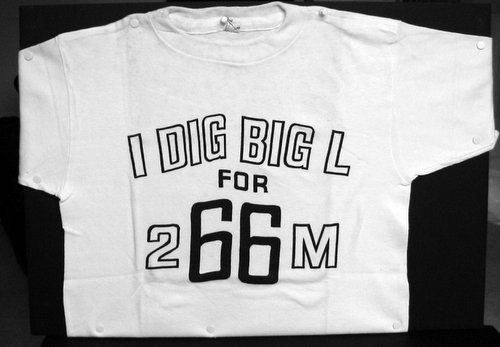
|
|
Radio London 1966 T-shirt, courtesy of Duncan Johnson.
|
In early 1966 a film called Dateline Diamonds went on general release. It was shot on a budget of just £27,000, so hardly a blockbuster, but it was heavily promoted on air. It appeared in cinemas as
part of a double bill supporting comedy film, Doctor In Clover. Dateline Diamonds featured shots of the Radio London ship as well as brief appearances from Kenny Everett, Tony
Windsor and Ben Toney, alongside stars William Lucas and Kenneth Cope. The Small Faces were also seen and heard, as was newcomer Kiki Dee.
In May it was announced that the transmitter power was being increased to 75 kilowatts at a cost of £50,000. In fact this never happened - it was just a publicity stunt timed to coincide with Caroline South increasing its power to
50 kilowatts.
Big L was the most profitable of all the offshore stations and for a while a northern sister station, Radio Manchester, was under active consideration although it never materialised.
|
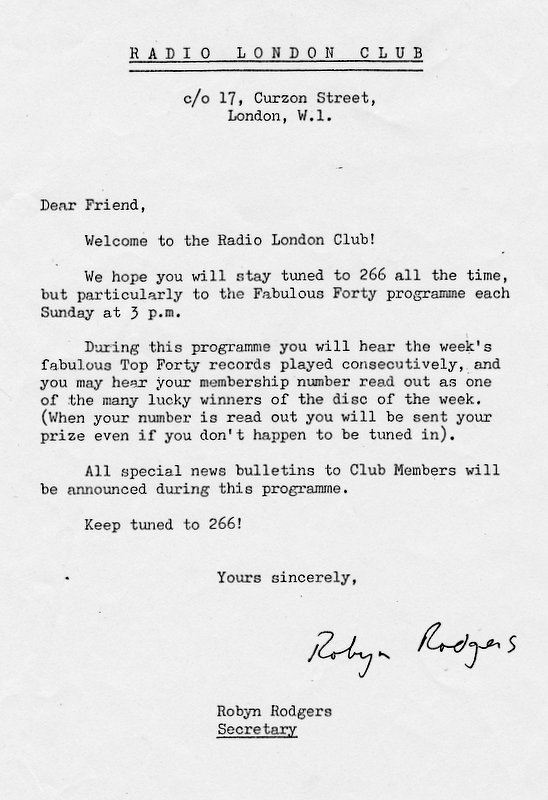
|
|
Welcome letter to the Radio London Club. Click to magnify.
|
|
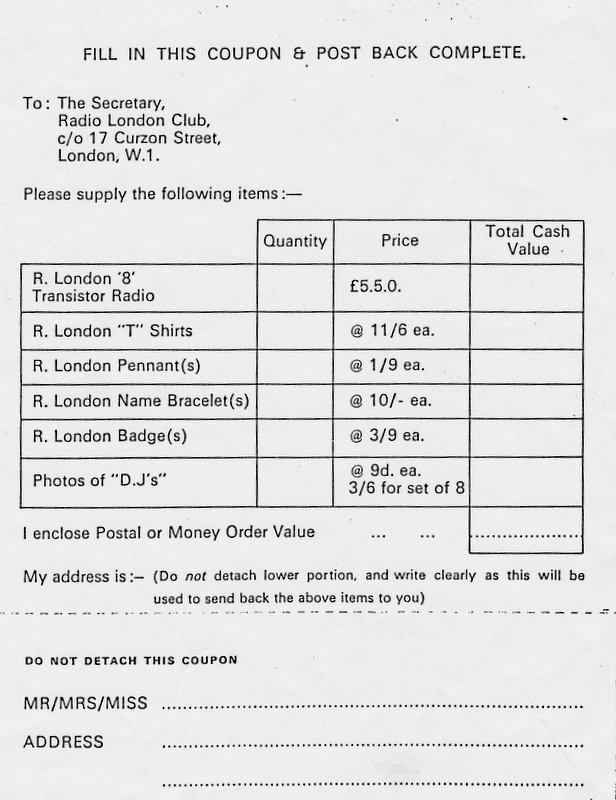
|
|
Items for sale from the Radio London Club. Click to magnify.
|
There were also plans for a second station in the south. Radio London had always kept to its very successful Top 40 format but in 1966 Philip Birch considered setting up a sweet music sister
station, UKGM (“United Kingdom Good Music”). This was to be based on the Shivering Sands fort in the Thames Estuary, home of Radio City. DJs Duncan Johnson and Keith
Skues were appointed to run the new service and plans were well advanced. Then the fort was hijacked by a rival pirate group (more details here). This led to the shooting of Radio City boss Reg Calvert. Radio
London immediately pulled out of the deal. Plans for UKGM were abandoned.
In July 1966, National Opinion Polls published the results of an audience survey which showed that Radio Caroline (both ships combined) had an audience of 8,818,000. Radio London's single ship had 8,140,000 listeners. (Radio 390 had 2,633,000, Radio England - which had only recently started full-time broadcasting - had 2,274,000, Radio Scotland had 2,195,000 and Britain Radio, Radio England's middle-of-the-road sister station, a mere 718,000.)
|
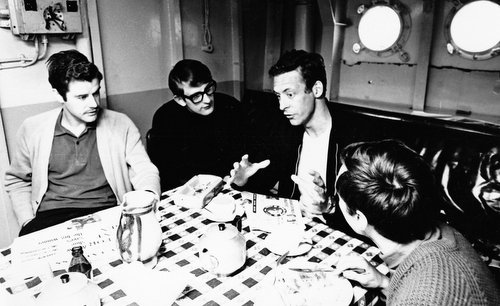
|
|
Left to right: Willy Walker, John Edward, Duncan Johnson and Kenny Everett (?) around the Radio London dining table. Photo published by the Free Radio
Association, kindly provided by George Morris.
|
 Now happily reinstated on Big L, Kenny Everett sitting in for Mike Lennox on Radio London's Breakfast Show, 2nd August 1966. Clip edited from a recording issued by the Radio Broadcasting Library. Tape from Martin Lynch's collection, kindly provided by Lynne Sims (duration 4 minutes 1 second)
Now happily reinstated on Big L, Kenny Everett sitting in for Mike Lennox on Radio London's Breakfast Show, 2nd August 1966. Clip edited from a recording issued by the Radio Broadcasting Library. Tape from Martin Lynch's collection, kindly provided by Lynne Sims (duration 4 minutes 1 second)
| RADIO LONDON PROGRAMME SCHEDULE, August 1966. |
weekdays
(excluding sponsored shows)
5.30am Mike Lennox
9.00 Tony Windsor
12.00pm Dave Dennis
3.00 Ed Stewart
6.00 Kenny Everett
9.00 Mark Roman
12.00am “London After Midnight”
Information from ‘The London Sound’.
|
|

